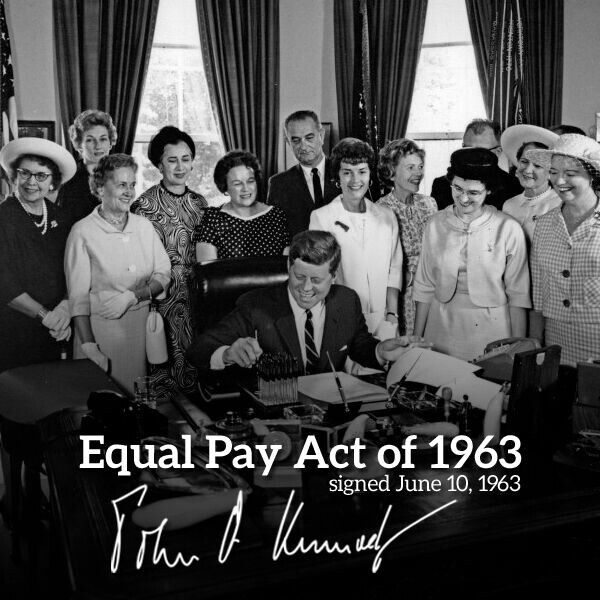In the United States of America, the gender wage gap is based on the statistic that a woman earns approximately $0.77 for every $1.00 that a man earns, but not many people understand how this figure is derived or what it even shows.1 By taking the median amount of earnings that women make in a single year and dividing this figure by the median amount of earnings that men make in a single year, the gap is revealed; however, this gap does not mean that, for the same work and qualifications, a woman will be paid $0.77 for every $1.00 that a man makes; this has been outlawed for decades: The 88th Congress of the United States passed the 1963 Equal Pay Act, which makes sex discrimination in the workforce illegal, and this law has been in effect for over fifty years.2 In addition, Harvard economist Claudia Goldin has stated that “the gender gap in wages is closing.”3 With this in mind, the question remains: why is there still a wage gap?

While it is true that there is a gap between the amount of money that men and women earn, the gap does not exist primarily because of sexism or discrimination (although this, unfortunately, is still a factor); instead, it is mainly because of the different life choices that the average man and the average woman make.
The data shows that men and women tend to go into different career fields. For example, women tend to go into the health services and social services sectors, while men tend to go into fields relating to science, technology, engineering, and mathematics (STEM).4 With regards to how the wage gap is calculated (dividing the median amount of earnings per year that a woman makes by the median amount of earnings per year that a man makes), it makes sense that there is a wage disparity if men tend to go into STEM fields while women tend to go into jobs relating to health and social services sectors.5 One could argue that more men go into STEM-related fields than women because of sexism or discrimination, and this may have been a valid point in the past; however, in recent years, the evidence reveals the opposite: women are prioritized in fields relating to STEM precisely because men tend to dominate in STEM-related careers. In fact, females are approximately two times as likely to be chosen over equally qualified men for STEM faculty positions.6 Further data from the Washington Post reveals that, even though the evidence shows that men tend to dominate in STEM fields, this is not primarily due to sexism or discrimination: “This is the latest in a series of studies by the Cornell researchers, many of which have concluded that the scarcity of female faculty in science departments (about 20 percent in most fields) can’t be blamed on innate sexism. In a study published in the journal Psychological Science in the Public Interest, they found that young and mid-career women are more likely to receive job offers than male candidates, are paid roughly the same amount, are granted tenure and promoted at the same rate (except in economics), remain in their fields for the same amount of time, and are about as satisfied with their jobs. The study attributes the lack of female scientists to early educational choices — like opting not to take Advanced Placement calculus and physics in high school or choosing not to declare a math-intensive major in college — rather than discrimination later on.”7
Regardless of where one is on planet earth, there will always be 24 hours in a day, 168 hours in a week, and 8,760 hours per year. Even though these numbers are the same for everyone on earth, everyone uses them differently in the workweek. For example, the average man working full time works 8.2 hours per day, while the average full-time woman works 7.8 hours per day. If men and women are compared further (without taking into account part-time work), then it’s revealed that men tend to work an average of 42 more minutes than women; although 42 minutes might not seem like much time, it does translate into many hours in the long run: an additional 42 minutes per day at work means that men, on average, are working 3.5 hours more than women per week, or an additional 14 hours per month.8 This extra amount of time means that men will be paid more money than women, since, on average, they work more than women. With this in mind, when calculating the earnings of women compared to the earnings of men, the disparity in wage makes sense.
Why is it that there is a vast disparity between the men and women in professional sports in the United States of America? The median salary for a player in the National Basketball Association (NBA) in 2015 was $2,505,720.9 The median salary for a player in the Women’s National Basketball Association (WNBA) is approximately $71,635.10 Even though both a woman from the WNBA and a man from the NBA are playing the same game, why is there a massive gap in the amount of money made? It appears that the answer can be derived from economics. With regard to economics, there are two forces at play: the law of supply and the law of demand. The law of demand states that there is an inverse relationship between price and quantity demanded.11 In other words, the more expensive a product becomes, the less likely consumers are to purchase it. The law of supply states that there is a positive relationship between price and quantity supplied.12 This means that if a supplier of a product realizes that the demand for a product is high, then the supplier can charge more money because he or she knows that people will pay for the product. Because the NBA knows the demand to see their games is high, the supplier (the NBA) can charge a lot of money for their tickets. On the other hand, the WNBA is not as popular compared to the NBA. Because the demand for WNBA games is not as high as NBA games, the supplier cannot charge as much money compared to the NBA, which means that the WNBA players will not make as much as NBA players. Another reason why NBA players tend to make more money is that their season is 82 games, while the WNBA players’ season is only 18 games; this means that there is more time for money to be collected for NBA players than in the WNBA. As can be seen, the disparity in money from an NBA player’s salary and a WNBA player’s salary has little to do with sexism or discrimination and everything to do with the way economics works.

It seems that the wage gap is primarily a product of multiple factors, such as the choice of job that the average man or the average woman takes, the number of hours that the average man and the average woman works, and because of economics. Having said this, what happens when these factors are accounted for? If the equation to find the gender wage gap accounts for these variables, then there is a small disparity between the amount of money that a man makes versus the amount of money that a woman makes. This small disparity seems like, unfortunately, a product of sexism and discrimination. One major form of discrimination in the workforce that women face is vertical (or hierarchical) segregation, which “refers to the fact that men are much more likely than women to be in positions of authority.”13 However, the United States government and businesses have begun to take notice of this and are now trying to do their best to reduce this form of discrimination. For example, women now own approximately half of all the United States companies.14 Also, President Barack Obama signed the Lilly Ledbetter Fair Pay Act in 2009, which made it much more difficult for businesses to take advantage of women by not paying them their fair share.15 This shows that, while discrimination and sexism play a role in a part of the wage gap, it is, thankfully, dying out and becoming less and less of a problem.

The gender wage gap is a complex issue. While it is still a problem in the United States of America, great strides are being made to reduce it. The gender wage gap appears to have multiple components, such as the amount of time working, the jobs that men and women go into, and, in part, economics. However, after accounting for this, there seems to be a percentage of the wage gap that doesn’t disappear; this percentage seems to be derived from sexism and discrimination. With this said, there is hope: laws have been passed in recent years to combat this unfortunate case of sexism and discrimination, and the workforce is more pro-women than at any other point in the history of the United States of America.16 Additionally, there is a global effort to reduce the inequality between man and woman: The United Nations adopted the Universal Declaration for Human Rights in 1948, which states that everyone has the right to equal pay for the same work.17 Although it is unfortunate that there is still a wage gap, there is a good trend in America with regards to the gender wage gap: it is decreasing. Hopefully, one day, the wage gap will be a thing of the past.
- Encyclopedia of Social Problems, 2008, s.v. “Wage Gap,” by Vincent N Parrillo. ↵
- The Wiley Blackwell Encyclopedia of Family Studies, 2016, s.v. “Gender Wage Gap,” by Emira Danad. ↵
- Reihan Salam, “Which Gender Gap?” National Review 66, no. 1 (January 27, 2014): 19-20. ↵
- “Students in STEM Fields by Gender and Race/Ethnicity,” CollegeBoard, https://trends.collegeboard.org/education-pays/figures-tables/students-stem-fields-gender-and-race-ethnicity. ↵
- Kerry Close, “STEM Majors Will Earn Highest Salaries This Year,” Time, January 21, 2016, http://time.com/money/4189471/stem-graduates-highest-starting-salaries/. ↵
- Ted Boscia, “Women Preferred 2:1 Over Men for STEM Faculty positions, “Cornell Chronicle, April 13, 2015, http://news.cornell.edu/stories/2015/04/women-preferred-21-over-men-stem-faculty-positions. ↵
- Sarah Kaplan, “Study Finds, Surprisingly, That Women Are Favored for Jobs in STEM,” The Washington Post, April 14, 2005, https://www.washingtonpost.com/news/morning-mix/wp/2015/04/14/study-finds-surprisingly-that-women-are-favored-for-jobs-in-stem/?noredirect=on&utm_term=.1be2c8a73649. ↵
- Karin Agness, “New Report: Men Work Longer Hours Than Women,” Forbes, June 30, 2016, https://www.forbes.com/sites/karinagness/2016/06/30/new-report-men-work-longer-hours-than-women/#7166f2e518b4. ↵
- Tome Gerencer, “How Much Money Does an NBA Player Make?” Money Nation, November 13, 2016, http://moneynation.com/how-much-money-does-an-nba-player-make/. ↵
- Paulana Lamonier, “The Business Of Being A WNBA Player,” Forbes, July 2, 2018, https://www.forbes.com/sites/plamonier/2018/07/02/the-business-of-being-a-wnba-player/#11d4d5c35af1. ↵
- Timothy Taylor, Courseware Print Companion for Micro Economics (unknown, 2016), 19. ↵
- Timothy Taylor, Courseware Print Companion for Micro Economics (unknown, 2016), 20. ↵
- Encyclopedia Britannica, 2018, s.v. “Gender wage gap,” by Medora W. Barnes. ↵
- Williams G. Nickels, James M. McHugh, and Susan M. McHugh, Understanding Business 12th Edition (New York: McGraw-Hill Education, 2016), 130. ↵
- From Suffrage to the Senate: America’s Political Women, 2013, s.v. “Lilly Ledbetter Fair Pay Act of 2009,” by Suzanne O’Dea. ↵
- Bryce Covert, “Closing the Wage Gap for Women,” New Republic, no. 249 (July 2018): 4-6. ↵
- Gale Encyclopedia of U.S. Economic History, 2015, s.v. “Gender Wage Gap,” by Ermira Danaj. ↵



44 comments
Jakob Trevino
This is a very descriptive article and there were some points that were new to me. Wage gaps between men and women still play a big role in our society today. Part of me believes that women get paid less because of maternity leave and companies do not want to pay more for someone who will not be working. This does not make sense to me and I would love to see a world where men and women are treated equally.
Victor Rodriguez
Wow, very well-written article! I believe that sexism and wage gap continues to be a major problem in this society. As an advocate for human rights, I think that if there should not be a wage difference as long as they both male and female are doing the same job. Why should one gender get that type of advantage over another? There is a lot of discrimination in the workforce and I believe that it is a major problem in our society. I am glad there are activists that are trying to even that gap. I also thought it was interesting how the article showed that the gap is not because of discrimination but because of other factors such as popularity, demand, etc.
Lesley Martinez
This article is well-written and very descriptive. It’s interesting to read about the wage gap, and even though race and sex are still an issue, another factor is economics, particularly supply and demand. The examples provided in this article, such as the wage gap between players in the NBA and WNBA and men vs women in STEM, are great ways to help the reader understand. I’m glad efforts including President Barack Obama signing the Lilly Ledbetter Fair Pay Act are working to end discrimination in the workforce. Enjoyed reading this article!
Anthony Coronado
The article is descriptive in the idea that sexism isn’t causing the wage gap but that is of supply and demand through the example of (WNBA to NBA players’ salary) compared to the status of leagues, to season length, popularity (social). As well as shown that women are met with equal comparisons in STEM fields, which was a primarily male-dominated field. The article shows that government Acts have been placed to eliminate sexism for worker’s comp to lead to more equal pay since the 1960s
Joanna Martinez
This was a very unique and interesting article that contained a clear and concise topic. It describes how the wage gap continues to exist even after the equal pay act of 1963 and how the issues were never resolved. I found it both discouraging and fascinating that women still do not have exact rights as men and more importantly that we still get a lower wage. Before the article, I was aware of the issue, but now I have a greater understanding of the measurement of wages and how men and women differ in the workforce.
Audrey Uribe
Very well put together argument of the political topic. I agree that lots of different factors make up the wage gap but I personally think the biggest factor is gender which can go both ways depending on the field of work but this article was well said and stayed very respectful to the subject and different views. I hope in the future this is no longer an issue.
Courtney Pena
It is unfortunate that the gender wage gap is still an issue that we are having today. It is also unfortunate to think that many of my female classmates are going to graduate soon and will personally be affected by this. Even though it has been more than 50 years since the Equal Pay Act, we are still not seeing it in society. Hopefully, equal pay will come very soon.
Jacqueline Mendez
I definitely don’t think that discrimination and sexism its a small part of the wage gap. I personally believe that thats the main reason why we have wage gaps. Even though that problem still exists in today’s world. It’s still a problem as women have to become their own bosses in order to be paid equally as a man. Although she would still l be look down upon by her fellow men partners.
Alin Bocardo Felix
The article mentions a reason behind the disparity, but there is no clarification: it is mentioned that, on average, males work 42 more minutes than women per day, which is then calculated further into the long run, but what is not explained is the reasoning behind this. Why do women receive less hours than men? Now the disparity of the NBA & the WNBA and the logic behind it is very reasonable and well explained; it is understandable that over time men playing sports are preferred, so now the issue no longer lies on simply their salary, but society showing more support for women, like the STEM careers that were explained.
Vania Gonzalez
This article was very interesting and you explained the many factors that could possibly contribute to this wage gap. Career choices is interesting in that wage gap because no one ever thinks about that when they argue the wage gap, but that is true men are typically in fields that could possibly pay a little more. But also in some certain jobs there is still sexism and discrimination on women so that is also a factor although you argue it.